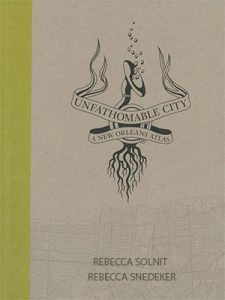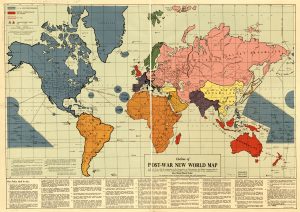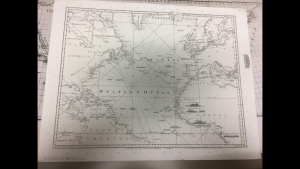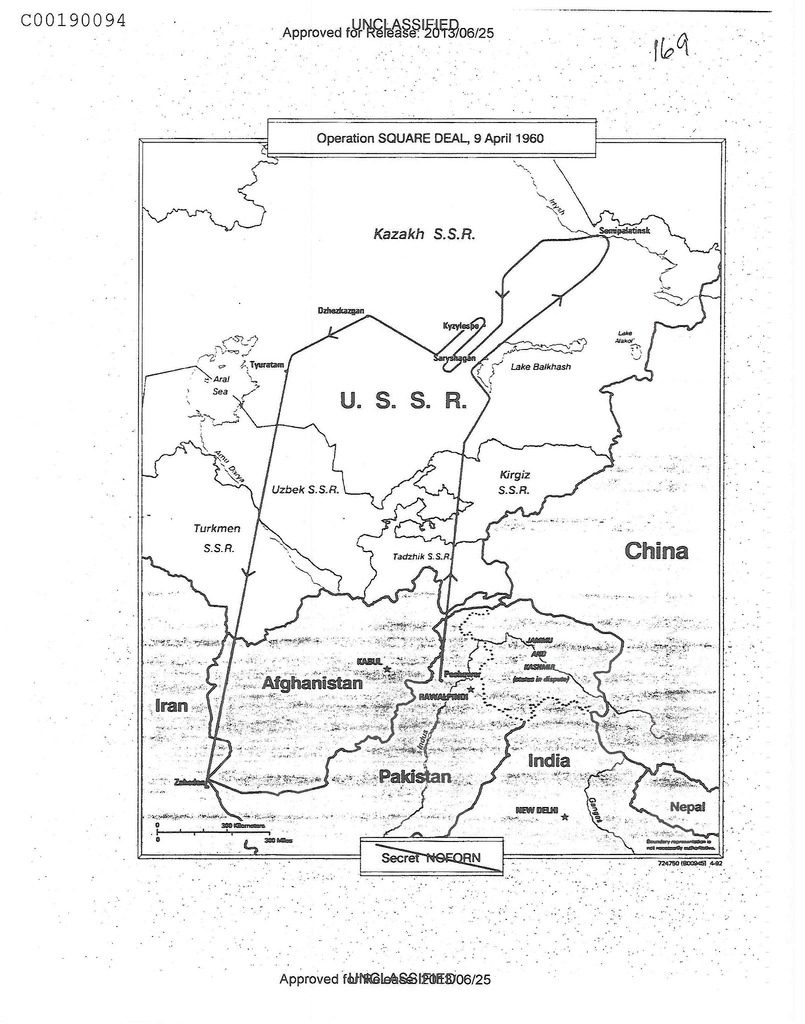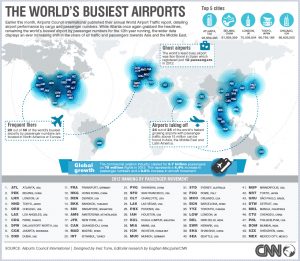
We all have the typical image of an airport: crowded, loud, chaotic. A place where everybody’s in a rush to get where they’re going and many people get lost in the confusion. This observation is typical of most, if not all, commercial airports, but imagine if Richmond’s airport had twice, three times, or even four times as many passengers flowing through its terminals. That kind of passenger density wouldn’t even come near the busiest airports in the world.
Suitably, the chaos of the map matches the chaos of the image of an airport. The map is cacophonous, with the many dots representing the airports overlapping each other to the point that the only distinguishing factor is the three letter acronym for each, of which many people are unfamiliar with. The five most visited airports are, in decreasing value, Atlanta with 95 million passengers, Beijing with 82 million, London with 70 million, and Tokyo and Chicago with roughly 67 million each, and yet there isn’t any visual element to make these more prominent on the actual map; instead, a small infographic is placed at the header to display these statistics. There are other, similar supplementary elements on this map, such as three ‘fun fact’ boxes with what the mapmakers believe are relevant, interesting statistics; a list of the fifty busiest airports in the world; a paragraph in the header giving the context of the map; and a footer that displays the extent of commercial aviation in a given year. I will identify and evaluate these supplements, visual elements, and statistics in detail later on, which will help to answer this general question: what do these values signify for global business, tourism, and political trends? Moreover, my initial question led to many others: Does this map represent any of this? By extension, how does this map portray the developing world? Can we draw any conclusions or inferences as a result? If there’s valuable information we cannot draw from this map, can we find other information to supplement it?
At first glance, the visual component of the map leaves much to be desired. Most of the significant information rests in the ‘Top 5’ figures in the top right corner, or the list of the 50 busiest airports situated at the bottom of the map. Many of the circles representing the map, though they vary in size to represent their influence, overlap with others. In doing so, the map fails to differentiate between any of the airports, so that it is impossible to immediately tell which airports are the busiest without further inspection. There’s a critical reason for this: the concentration of the airports in a limited geographic area. Areas such as the United States, Europe, and Asia comprise the bulk of airplane travel, leaving Latin America and Africa particularly sparse. In fact, the map points out that “29 out of 50 of the world’s busiest airports by passenger numbers are located in North America or Europe.” It’s worth noting that nine of the ten largest economies in the world are in North America, Asia, and Europe. Therefore, we would assume there would be higher business based travel across these three continents. Furthermore, the nations of North America and Europe carry greater income per capita than any other region on the earth, and so their citizens are more apt, willing, and able to travel by airplane. Thus, the assumption is that, when evaluating the locations of the busiest airports, they can be seen as an indicator for economic power and wealth.
That viewpoint does not always make sense, though. Why should an individual airport such as Atlanta elicit so much passenger density and frequency? Are there some airports we’re surprised are smaller than others? For instance, would you expect the Jakarta, Indonesia international airport to be busier than the Denver’s? Would you expect Denver’s to be busier than JFK in New York City? These questions would have more to do with our expectations and perceptions of economic power. We would expect New York City to be a powerful entity in the realm of aviation because of our knowledge of it as an economic capital. However, what that perspective does not take into account is the location. Denver is located halfway across the United States, thus making it optimal for stopover and direct flights to cities in the inland of the United States. Similarly, Jakarta is in the heart of Asia, where not only is there massive population, including 250 million in Indonesia alone, but it’s between the economic superpowers of Japan, South Korea, China, Singapore, India, and Australia. Simply put, our perception of the world and its significant regions have been shaped by social construction, causing us to lose sight of some of the variables that would influence human migration. Our busiest airports are not just influenced by business, but also tourism, diplomacy, finance, location relative to other nations, and simply population size. Yet there is not a statistic breaking down the purpose of air travel, only the end result.
Despite this breakdown, there is still some the map has us infer about the developing world, as those airports that would have been found in developing nations are absent. Also, there is no visual data on which airports are growing and at which rates, a detail that would have been beneficial if the map’s intention was to highlight the the aviation industry’s growth into new regions. Regardless, the map gives a small nod to developing nations with the statistic that “24 out of 25 of the world’s fastest growing airports with passenger traffic above 15 million can be found in Asia, the Middle East, and Latin America.” Why would the mapmakers decide to include this statistic? Because if an airport in a city is growing, that could serve as an indicator that the finance and business sectors of the respective city are developing. As it stands, nations like China, India, Brazil, Myanmar, and Bangladesh are seeing high rates of economic growth and development that correspond with the increased travel through their airports. In a way, then, mapmakers used this statistic to point out the progress of the developing world. The mapmakers thus reaffirm the use of maps as a political tool, as maps continue to display a certain image of the world. For one, we are seeing the relative strength of Western civilization, and immediately infer prosperity in those regions. In contrast, in the empty regions of Africa and South America, they are mostly empty, and thus denote poverty and lower economic development. While this is not a pointed, intentionally hostile decision, it leaves any observer of the map to ignore the prospects of a developing nation. The inclusion of the statistics of the developing world are thus made necessary.
Therefore, it cannot be said there was a practical intention for this map, be it to portray why passengers are traveling or how these transportation hubs are growing. Rather, as it is from the news agency CNN and made to be a visually appealing graphic, it carries a purpose more towards entertaining the general public. The map does so by displaying the presently immense, wide scale of aviation, and alludes to both the industries humble past and potential for the future. For instance, in the header explaining the data of the map, the mapmakers note that “the wider data displays an ever increasing shift in the star of air traffic and passengers towards Asia and the Middle East.” There is effective depiction of the developing world without detracting from the central purpose of the map, as they imply growth in the future of aviation in new regions. As for the present strength of the aviation industry, the map makes it known that “the commercial aviation industry catered for 5.7 billion passengers on 79 million flights in 2012,” of which represent “a 4.4% increase in passenger numbers and a 0.6% increase in aircraft movement.” The map represents and industry that is growing, an industry synonymous with human innovation and progress. It only made sense that they made a nod to the developing world, and while that could have been more pronounced, it remained fitting to the central purpose of the map.

